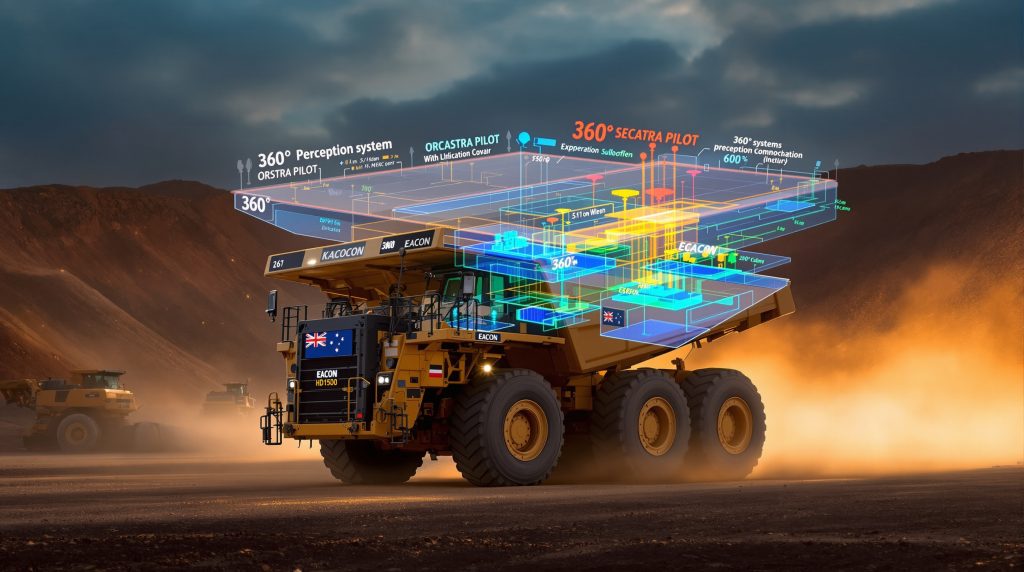The Autonomous Mining Revolution: EACON's Agnostic Technology Transforms Australian Operations
The mining industry is witnessing a significant transformation with the introduction of vendor-neutral autonomous systems that promise to revolutionize operations. EACON Mining Technology has recently begun testing its agnostic autonomous technology at Norton Gold Fields in Kalgoorlie, Western Australia, marking a pivotal moment for the Australian mining sector. This development represents a key advancement in AI in Mining Innovation that could reshape operational standards across the continent.
What is OEM-Agnostic Autonomy and Why Does It Matter for Mining?
Understanding the Concept of Vendor-Neutral Autonomous Systems
Traditional autonomous mining technology has typically been tied to specific equipment manufacturers, creating operational silos and limiting flexibility for mining companies. OEM-agnostic systems break this dependency by offering universal compatibility across different truck brands and models regardless of manufacturer.
The key advantage of this approach is that mining companies can retrofit their existing fleets rather than investing in all-new autonomous-ready equipment. This significantly reduces capital expenditure while extending the productive life of current assets, some of which represent investments of millions of dollars.
Vendor-neutral systems essentially create a standardized interface that can work with various equipment types, allowing miners to maintain mixed fleets while still achieving consistent autonomous operation across their sites.
The Economic and Operational Benefits of Equipment-Agnostic Solutions
The financial advantages of vendor-neutral autonomous systems extend far beyond initial capital savings. These solutions eliminate the need for complete fleet replacement, which traditionally represents one of the largest barriers to automation adoption in the mining industry.
By enabling gradual implementation across existing equipment, mining operations can spread their investment over time while immediately beginning to capture operational benefits. Industry analysts estimate that retrofitting existing haul trucks typically costs 30-40% of purchasing new autonomous-ready equipment.
Additional benefits include reduced integration complexity between different equipment brands and the creation of more competitive supplier markets. This helps Australian mining operations facing cost pressures and increasingly stringent sustainable mining transformation targets to adopt automation technologies without the traditional vendor lock-in challenges.
For remote Australian operations where equipment replacement logistics can be particularly challenging, the ability to upgrade existing assets in-place provides substantial logistical advantages as well.
How Is EACON's Autonomous Technology Being Tested in Australia?
The Landmark Kalgoorlie Testing Program
EACON Mining Technology has commenced a groundbreaking autonomous haulage trial at Norton Gold Fields in Kalgoorlie, Western Australia. At the center of this testing program is a retrofitted Komatsu HD1500 haul truck, nicknamed "Jerry," which has been equipped with EACON's comprehensive autonomous technology suite.
This milestone represents the first deployment of EACON's agnostic autonomy system on Australian soil. While the technology arrives with proven credentials, having already logged over 50 million kilometers of real-world operation globally, the Australian testing phase is critical for validating performance in the unique challenges presented by Australian mining environments.
The choice of Kalgoorlie as a testing location is strategic, as the region offers representative conditions that include varied terrain, dust challenges, and typical operational patterns found across many Australian mining operations. The program aligns with broader industry innovation trends that emphasize adaptability and technological integration.
Key Components of the ORCASTRA PILOT System
The testing program showcases EACON's comprehensive ORCASTRA PILOT kit, which transforms conventional haul trucks into autonomous vehicles through a sophisticated suite of integrated technologies.
The system includes:
- Multi-sensor perception systems providing 360° environmental awareness
- Advanced onboard computing units for real-time decision making
- Integrated LTE/5G communication modules for reliable connectivity
- Vehicle-to-vehicle (V2V) networking capabilities for fleet coordination
- Universal Drive-by-Wire system adaptable to various truck models
These components work together to enable safe, intelligent autonomous operation even in challenging mining conditions typical of Australian operations. The multi-layered approach to environmental perception is particularly important, as it combines various sensing technologies to ensure reliable operation in the diverse environmental conditions found across Australian mining sites.
The system's universal drive-by-wire capabilities represent a core technical innovation, creating a standardized interface that allows the autonomous control system to effectively manage various truck models without requiring manufacturer-specific engineering solutions.
What Makes Australian Mining Conditions Unique for Autonomous Systems?
Regulatory and Safety Compliance Challenges
Australia maintains some of the world's most stringent mining safety standards, requiring autonomous systems to meet comprehensive certification requirements before deployment. These include detailed risk assessments, emergency response protocols, and worker safety integration plans that exceed regulations in many other mining regions.
The Australian mining regulatory framework places particular emphasis on change management and risk assessment during technology transitions. This requires autonomous system providers to demonstrate not just the technical capabilities of their solutions, but also comprehensive safety integration with existing operations and workforce.
EACON's testing program has been specifically designed to validate compliance with these regulatory frameworks while demonstrating operational reliability in active mining environments. The progressive implementation approach allows for systematic safety validation at each stage of autonomy.
Environmental and Operational Considerations
Australian mining sites present distinct environmental challenges that can test the limits of autonomous systems. These include:
- Extreme temperature variations ranging from below freezing to over 45°C
- Intense dust conditions that can compromise sensor systems
- Complex terrain with variable surfaces and gradients
- Remote locations with connectivity challenges
- Seasonal weather variations including monsoon conditions in northern regions
The Kalgoorlie testing ground provides an ideal proving environment for validating how autonomous systems perform under these conditions. The trial will specifically assess system resilience against factors like signal interference, dust impact on sensors, and navigation accuracy in variable terrain.
Australian operations also typically involve longer haul distances than many international mines, placing greater demands on autonomous system reliability and connectivity over extended operational periods. This makes data-driven mining approaches particularly valuable for maintaining system performance.
How Does EACON's Global Experience Translate to Australian Operations?
Scale and Scope of Previous Deployments
EACON brings substantial operational experience to the Australian testing program, with approximately 1,800 autonomous trucks currently deployed across more than 25 mine sites globally. This extensive fleet has accumulated over 50 million kilometers of autonomous operation, providing valuable data and insights that inform the Australian implementation.
This global experience spans diverse mining environments including hard rock operations, coal mines, and various terrain types, offering a strong foundation for addressing Australia-specific challenges. The company's experience with mining operations across different regulatory environments globally has also informed its approach to Australian compliance requirements.
The scale of EACON's global deployments provides valuable reliability data, with their systems demonstrating consistent performance across various operational conditions and equipment types that overlap with Australian mining requirements.
Adaptation Strategy for Australian Mining Requirements
To ensure successful implementation in the Australian context, EACON has established a dedicated Australian team with over two decades of combined autonomous haulage operational experience. This team has provided specialized design input and feature characterization to adapt the technology to local requirements.
By embedding Australian mining expertise directly into the system architecture and operational protocols, EACON aims to address the specific needs of Australian operations from the outset rather than retrofitting global solutions to local requirements.
The Australian team's focus includes:
- Alignment with local regulatory frameworks
- Optimization for Australian environmental conditions
- Integration capabilities with mining systems commonly used in Australian operations
- Customization of operational parameters for typical Australian mining patterns
This localized approach recognizes that while the core technology has proven effective globally, successful implementation in Australia requires deep understanding of local operational contexts and requirements.
What Does the Testing Timeline and Implementation Roadmap Look Like?
Current Testing Phase Objectives and Progress
The initial testing phase at Norton Gold Fields focuses on comprehensive verification of the autonomous system's performance in controlled conditions. This stage establishes baseline performance metrics across key operational parameters before advancing to more complex scenarios.
Early data from these tests indicates the system is meeting performance expectations, with the project progressing according to schedule. This validation stage examines fundamental capabilities including:
- Navigation accuracy and precision
- Obstacle detection and avoidance reliability
- Communication system performance
- Integration with site management systems
- Operational consistency across various conditions
Each of these parameters is being systematically evaluated against predetermined performance benchmarks to ensure the system meets both technical requirements and operational expectations before advancing to the next implementation phase.
Pathway to Full Production Implementation
Following the controlled testing phase, the program will advance to live trials in active open pit mining environments. This progressive implementation approach allows for systematic validation under increasingly complex operational conditions.
The comprehensive roadmap includes:
- Controlled environment testing (current phase)
- Limited operational area trials with human supervision
- Expanded operational zone testing with reduced supervision
- Integration with existing fleet management systems
- Full production deployment
Each stage incorporates comprehensive safety protocols and performance validation before proceeding to the next level of autonomy. This graduated approach aligns with Australian mining's safety-first philosophy and allows for controlled risk management throughout the implementation process.
The timeline for progression through these phases depends on performance validation at each stage, with the potential for acceleration based on consistent system performance and regulatory approval.
How Will This Technology Impact the Future of Australian Mining?
Productivity and Safety Enhancements
Autonomous haulage systems have demonstrated significant productivity improvements in global mining operations, with potential benefits for Australian implementations including:
| Performance Metric | Typical Improvement Range |
|---|---|
| Operating hours per day | 15-20% increase |
| Cycle time consistency | 10-15% improvement |
| Fuel efficiency | 8-12% reduction in consumption |
| Maintenance costs | 5-8% reduction through optimized operation |
| Safety incidents | 35-50% reduction in reportable events |
These improvements directly address key challenges facing Australian mining operations, including labor shortages in remote regions, increasingly stringent safety requirements, and ongoing cost pressures in a competitive global market.
The consistency of autonomous operations also provides operational predictability that supports more efficient mine planning and resource utilization, potentially extending mine life through more efficient extraction methodologies.
Workforce Transformation and Skills Development
The implementation of autonomous technology creates opportunities for workforce evolution rather than simple displacement. While autonomous systems reduce the need for traditional equipment operators, they create demand for new roles in:
- Autonomous system monitoring and management
- Data analysis and operational optimization
- Remote operations center staffing
- Maintenance of autonomous systems
- Integration engineering
This transition requires investment in skills development programs to prepare the existing workforce for these emerging roles. Forward-thinking mining operations are already establishing training pathways to facilitate this transition, often in partnership with technology providers and educational institutions.
The shift toward higher-skilled technical positions can help attract new talent to the mining sector while providing career advancement paths for existing workers. This addresses persistent challenges in workforce attraction and retention, particularly in remote mining regions.
What Are the Key Technical Innovations in EACON's Approach?
Universal Drive-by-Wire System Architecture
At the core of EACON's agnostic approach is its proprietary Drive-by-Wire system, which creates a standardized interface between the autonomous control system and various truck models. This universal adapter layer enables consistent autonomous operation regardless of the underlying truck manufacturer or model.
This technical innovation eliminates the need for manufacturer-specific integration and allows mining companies to maintain mixed fleets while still achieving autonomous operation. The system works by creating an abstraction layer that translates standardized control commands into the specific inputs required by each vehicle's existing control systems.
The Drive-by-Wire system includes:
- Universal control interfaces adaptable to different vehicle types
- Standardized command protocols across various equipment models
- Redundant safety systems to ensure reliable operation
- Diagnostic capabilities that integrate with existing vehicle systems
This approach provides both technical and economic advantages, as it reduces implementation complexity while maximizing the value of existing fleet assets. The technology shares many principles with AI mill optimization systems that are transforming other areas of mining operations.
Advanced Perception and Decision-Making Capabilities
The system employs multi-layered environmental perception combining:
- LiDAR for precise distance measurement and object detection
- Radar for all-weather operation and velocity detection
- Computer vision for classification and contextual understanding
- GPS and inertial navigation for precise positioning
This sensor fusion approach creates redundant safety systems while enabling the autonomous vehicles to navigate complex mining environments with high reliability even in challenging conditions like dust, rain, or low light.
The perception system works in conjunction with advanced decision-making algorithms that prioritize safety while optimizing operational efficiency. This includes path planning capabilities that consider both immediate obstacle avoidance and long-term route optimization to maximize productivity and minimize wear on both vehicles and haul roads.
FAQ: EACON's Autonomous Mining Technology in Australia
How does retrofitting compare to purchasing new autonomous-ready equipment?
Retrofitting existing haul trucks with autonomous technology typically costs 30-40% of purchasing new autonomous-ready equipment. Beyond the direct capital savings, the approach also extends the productive life of existing assets while providing comparable performance to purpose-built autonomous vehicles.
For mining operations with substantial existing fleets, retrofitting offers a phased implementation path that minimizes capital expenditure while still delivering the operational benefits of autonomy. This approach also reduces the environmental impact associated with manufacturing new equipment and disposing of functional existing assets.
The retrofitting process typically requires 2-4 weeks per vehicle, allowing for graduated implementation that minimizes operational disruption compared to wholesale fleet replacement.
What safety protocols ensure autonomous and manned vehicles can operate together?
Mixed fleet operations employ multiple safety systems to ensure safe interaction between autonomous and manually operated equipment. These include:
- Geofenced operational zones that segregate autonomous and manual operations
- Vehicle-to-vehicle communication networks that track all equipment in real-time
- Centralized traffic management systems with priority protocols
- Proximity detection and collision avoidance systems
- Dedicated communication channels for operational coordination
Human-operated vehicles in autonomous zones are equipped with transponders that make them visible to autonomous systems, while operators receive real-time location data for all autonomous equipment. These systems create multiple redundant safety layers to prevent potential interactions and ensure operational safety.
Regular safety drills and emergency response protocols are also essential components of mixed fleet operations, ensuring all personnel understand interaction procedures and emergency measures.
How does autonomous technology impact environmental sustainability in mining?
Autonomous haulage contributes to sustainability objectives through several operational improvements:
- Optimized route planning reduces total distance traveled
- Consistent driving patterns minimize fuel consumption
- Reduced idle time improves overall energy efficiency
- Precise operation reduces road wear and maintenance requirements
- Optimized acceleration and braking patterns minimize tire wear
These improvements typically reduce fuel consumption by 8-12% compared to manual operation, with corresponding reductions in emissions. The systems also minimize road wear through consistent driving patterns, reducing dust generation and extending haul road maintenance intervals.
For Australian mining operations working toward ambitious sustainability targets, autonomous systems provide measurable emissions reductions while maintaining or improving productivity, supporting both environmental and economic objectives.
The Future Outlook for Autonomous Mining in Australia
The successful implementation of EACON's agnostic autonomy testing on Australian soil could significantly accelerate the adoption of autonomous systems across the mining sector. By removing the barrier of vendor lock-in and enabling gradual implementation on existing fleets, this approach addresses key economic and operational challenges that have limited automation adoption.
As Thiess and Norton Gold Fields continue their partnership in this autonomous mining initiative, the industry is watching closely to see how this technology performs in real Australian conditions. According to recent Austmine reports, the agnostic approach to autonomy represents one of the most significant technological shifts in mining operations this decade.
The data generated through this initial testing phase will provide valuable insights not just for EACON and their implementation partners, but for the broader mining industry as it navigates the transition toward increasingly autonomous operations in one of the world's most important mining regions.
For mining operations considering autonomous technology implementation, this testing program provides an important case study in how agnostic systems can bridge the gap between traditional operations and the fully autonomous mining operations of the future.
Want to Capitalise on the Next Major Mining Discovery?
Discover why major mineral finds can lead to exceptional returns by exploring Discovery Alert's dedicated discoveries page, where our proprietary Discovery IQ model delivers real-time alerts on significant ASX mineral discoveries, transforming complex data into actionable investment insights.




